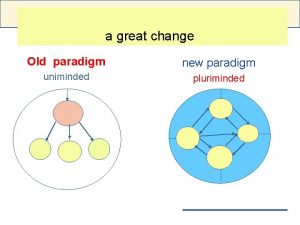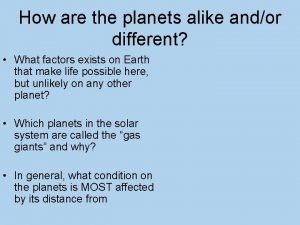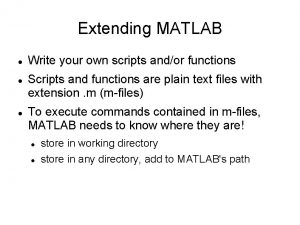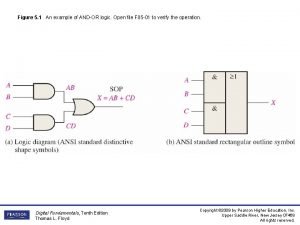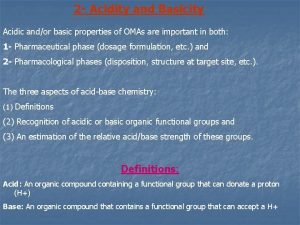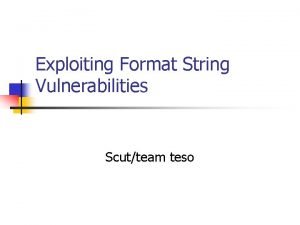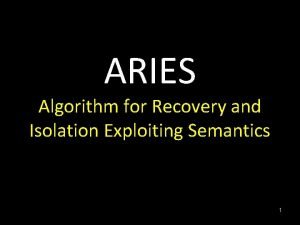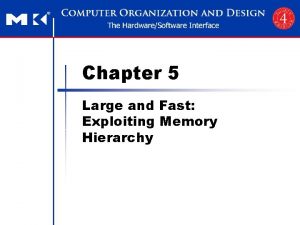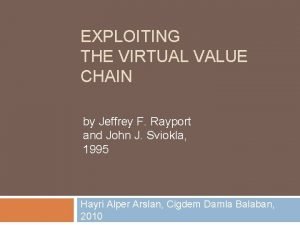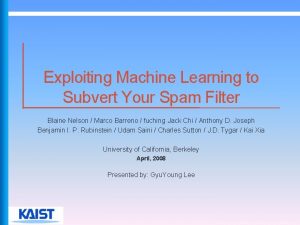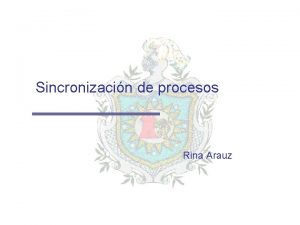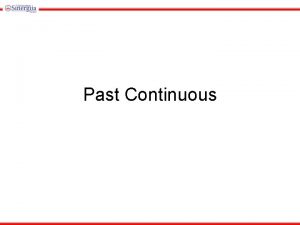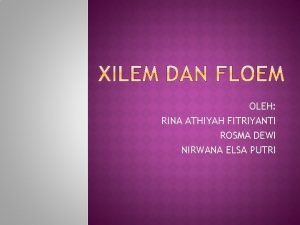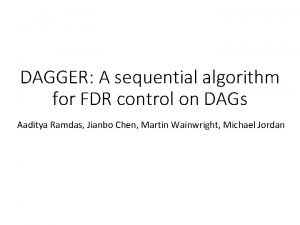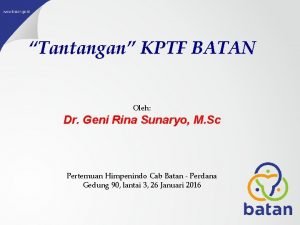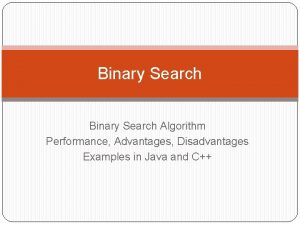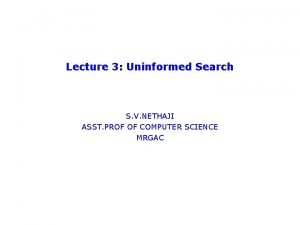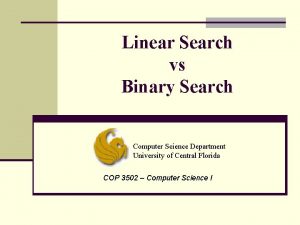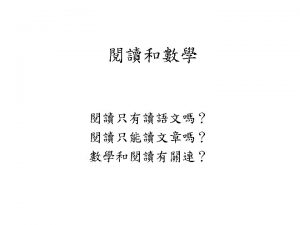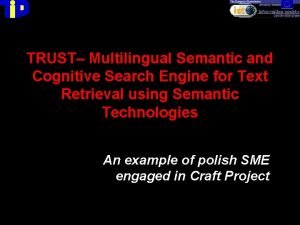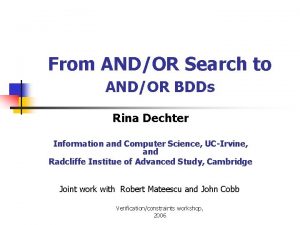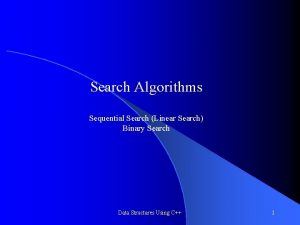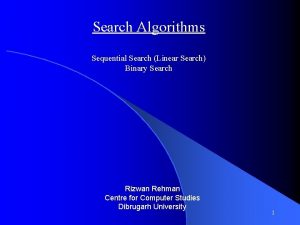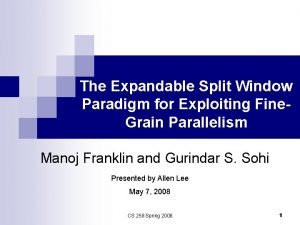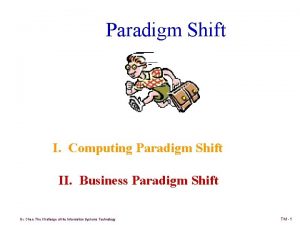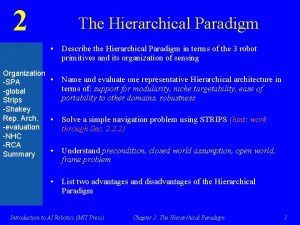Exploiting TreeDecomposition in Search The ANDOR Paradigm Rina






















































- Slides: 54

Exploiting Tree-Decomposition in Search: The AND/OR Paradigm Rina Dechter Bren School of ICS University of California, Irvine Collaborators: Kalev Kask Radu Marinescu Robert Mateescu Vibhav Gogate Vienna, Dec 2004 Caltech, December 1 st

Outline n n Background: Search and inference in Graphical models AND/OR search trees n n AND/OR search graphs n n Pseudo spanning trees, dfs trees Tree-width and path-width bounds Relationship to algorithmic and compilation schemes. Vienna, Dec 2004

Constraint networks A 1 1 2 2 3 3 B 2 3 1 2 The main task: n n Determine if the problem has a solution (an assignment that satisfies all the relations); If yes, find one or all of them. Vienna, Dec 2004 A 1 2 3 A B C D F G A 1 1 2 2 3 3 B 2 3 1 2 D 3 2 3 1 2 1 D F G 1 2 3 2 1 3 A C 1 2 3 2 B C F 1 2 3 3 2 1

Probabilistic Networks Smoking P(S) P(C|S) P(B|S) lung Cancer Bronchitis P(X|C, S) X-ray P(D|C, B) Dyspnoea CPD: C 0 0 1 1 B D=0 D=1 0 0. 1 0. 9 1 0. 7 0. 3 0 0. 8 0. 2 1 0. 9 0. 1 P(S, C, B, X, D) = P(S) P(C|S) P(B|S) P(X|C, S) P(D|C, B) P(S|d)= ? MPE: argmax P(S) P(C|S) P(B|S) P(X|C, S) P(D|C, B) Vienna, Dec 2004

Graphical models n A graphical model (X, D, C): n n n X = {X 1, …Xn} variables D = {D 1, … Dn} domains C = {F 1, …, Ft} functions (constraints, CPTS, cnfs) A F B E Vienna, Dec 2004 C D

Graphical models n A graphical model (X, D, C): n n n X = {X 1, …Xn} variables D = {D 1, … Dn} domains C = {F 1, …, Ft} functions (constraints, CPTS, cnfs) A F B Operators: combine and project: q. MPE: max. X j Pj q. CSP: X j Cj q. Max-CSP: min. X j Fj q. Belief updating: X-y j Pi Vienna, Dec 2004 E n n n C D All these tasks are NP-hard identify special cases approximate

Solution Techniques Search: Conditioning Incomplete Complete Simulated Annealing Dfs search, Branch and bound, A* Gradient Descent Incomplete Complete Local Consistency Unit Resolution mini-bucket(i) Adaptive Consistency Tree Clustering Dynamic Programming Resolution Inference: Elimination Vienna, Dec 2004

Solution Techniques Search: Conditioning Time: exp(n) Space: linear Incomplete Complete Simulated Annealing Gradient Descent Hybrids Complete Time: exp(w*) Space: exp(w*) Incomplete Local Consistency Unit Resolution mini-bucket(i) Adaptive Consistency Tree Clustering Dynamic Programming Resolution Inference: Elimination Vienna, Dec 2004

Solution Techniques AND/OR search Search: Conditioning Time: exp(w* log n) Space: linear Incomplete Complete Simulated Annealing Gradient Descent Hybrids: AND-OR(i) Space: exp(i) Time: exp(C_i) Complete Incomplete Local Consistency Unit Resolution mini-bucket(i) Adaptive Consistency Tree Clustering Dynamic Programming Resolution Inference: Elimination Vienna, Dec 2004 Time: exp(w*) Space: exp(w*)

Bucket Elimination Adaptive Consistency (Dechter & Pearl, 1987) E || RDCB || RAB RA C B A || RDBE , RCBE || RE D A D C B E Vienna, Dec 2004

Outline n n Background: Search and inference in Graphical models AND/OR search trees n n AND/OR search graphs n n Pseudo spanning trees, dfs trees Tree-width and path-width bounds Relationship to algorithmic and compilation schemes. Vienna, Dec 2004

OR search space A F B E A 1 0 E 1 0 C F D 0 B D Ordering: A B E C D F C 1 0 0 1 1 0 0 1 0 1 1 0 0 0 1 1 0 1 0 1 0 1 0 1 0 1 Vienna, Dec 2004 1 0 1 1 0 0 0 1 1 0 1 0 1 1 0 1 0 1 0 1 0 1 0 1

AND/OR search space A A A F B C B C C E E D E Primal graph D D F DFS tree OR A AND 0 1 OR B B AND 0 OR AND E 0 OR AND C 1 E 0 1 D 0 F 1 0 0 D 1 0 F 1 0 Vienna, Dec 2004 0 0 F 1 0 1 D 1 E C 1 0 D 1 1 0 1 0 E 0 1 D F 1 C F 1 0 0 D 1 0 1 F 1 0 C 0 1 D 1 0 F 1 0 1

A A F B OR vs AND/OR OR E 0 1 OR B B AND 0 OR C D D F 0 C 1 OR 1 D AND 0 E 0 F 1 0 0 D 1 0 F 1 0 1 A 0 0 F 1 0 D 1 0 C 0 1 D 1 E C 1 AND/OR 0 1 E AND 1 1 0 0 1 D F 0 1 E F 1 0 0 D 1 0 1 0 C 1 0 0 1 1 0 1 0 1 D 1 F 0 1 0 D 1 0 F 1 0 1 1 0 1 0 1 1 0 0 0 1 OR 1 0 0 1 0 1 0 1 0 1 Vienna, Dec 2004 1 0 0 1 0 E C 1 F 0 B F E A AND D B C 0 1 1 0 1 0 1 1 0 1 0 1 0 1 0 1 0 1

A A F AND/OR vs. OR OR B B C E E C D D F A AND 0 1 OR B B AND 0 OR AND 0 C 1 OR 0 E 0 1 D AND F 1 0 1 E 0 0 D 1 0 F 1 0 0 1 0 F 1 0 D 1 0 C 0 1 D 1 E C 1 AND/OR 1 1 0 0 1 D F 0 1 E F 1 0 0 D 1 0 1 F 1 0 C 0 1 D 1 F 0 1 0 D 1 0 F 1 0 1 AND/OR size: exp(4), OR size exp(6) A 0 B 0 E F 1 0 C D 1 1 0 0 0 1 1 0 0 Vienna, Dec 2004 1 0 1 1 0 0 0 1 1 0 1 0 1 0 1 0 1 0 1 1 0 0 0 1 OR 1 0 1 0 1 0 1 0 1 0 1 0 1

AND/OR vs. OR OR F B E C D D F A 0 1 OR B B AND 0 OR 0 C 1 OR 1 D AND 0 E 0 F 1 0 0 D 1 0 F 1 0 1 A 0 0 F 1 0 D 1 0 C 0 1 D 1 E C 1 AND/OR 0 1 E AND 1 1 0 0 1 D F 0 1 E F 1 0 0 D 1 0 1 0 C 1 0 0 1 1 0 Vienna, Dec 2004 1 0 1 1 D 1 F 0 1 0 D 1 0 0 0 F 1 0 1 1 0 E C 1 F 0 B F B C E AND D A A No-goods (A=1, B=1) (B=0, C=0) 0 1 1 0 0 0 1 1 0 1 0 1 0 1 0 1 0 1 1 0 0 0 1 OR 1 0 1 0 1 0 1 0 1 0 1 0 1

F B AND/OR vs. OR OR 1 OR B B AND 0 OR E 0 C E 1 1 0 D AND 0 1 0 0 0 F 1 0 1 D 1 E C 1 F A C D F AND/OR 0 D 1 0 C 1 1 D F 1 0 0 1 F 1 0 B 1 0 0 1 1 C F E 0 1 OR D D B A 0 E C E AND A A (A=1, B=1) (B=0, C=0) 0 1 1 0 0 1 0 1 0 Vienna, Dec 2004 1 0 1 1 0 0 0 1 OR 0 0 1 1 1 0 1 0 1 0 1 0 1 0 1

OR space vs. AND/OR space width AND/OR space height time(sec. ) nodes backtracks time(sec. ) AND nodes OR nodes 5 10 3. 154 2, 097, 150 1, 048, 575 0. 03 10, 494 5, 247 4 9 3. 135 2, 097, 150 1, 048, 575 0. 01 5, 102 2, 551 5 10 3. 124 2, 097, 150 1, 048, 575 0. 03 8, 926 4, 463 4 10 3. 125 2, 097, 150 1, 048, 575 0. 02 7, 806 3, 903 5 13 3. 104 2, 097, 150 1, 048, 575 0. 1 36, 510 18, 255 5 10 3. 125 2, 097, 150 1, 048, 575 0. 02 8, 254 4, 127 6 9 3. 124 2, 097, 150 1, 048, 575 0. 02 6, 318 3, 159 5 10 3. 125 2, 097, 150 1, 048, 575 0. 02 7, 134 3, 567 5 13 3. 114 2, 097, 150 1, 048, 575 0. 121 37, 374 18, 687 5 10 3. 114 2, 097, 150 1, 048, 575 0. 02 7, 326 3, 663 Vienna, Dec 2004

From DFS trees to pseudo-trees (Freuder 85, Bayardo 95) 4 1 1 6 2 3 2 7 5 3 (a) Graph 4 1 2 7 1 7 3 5 4 5 3 4 2 7 6 (b) DFS tree depth=3 Vienna, Dec 2004 (c) pseudo- tree depth=2 5 6 6 (d) Chain depth=6

From DFS trees to Pseudo-trees OR 1 AND a OR b 2 7 AND a b c OR 3 3 3 5 5 5 DFS tree AND a b c a b c OR 4 4 4 4 4 6 6 6 6 6 AND 1 AND a OR b 3 AND depth = 3 a b c a b c a b c a b c a b c OR OR c a c 5 b c a b c 4 2 4 2 7 6 7 6 a b c a b c a b c Vienna, Dec 2004 pseudo- tree depth = 2

Finding min-depth backbone trees n n Finding min depth DFS, or pseudo tree is NPcomplete, but: Given a tree-decomposition whose tree-width is w*, there exists a pseudo tree T of G whose depth, satisfies (Bayardo and Mirankar, 1996, bodlaender and Gilbert, 91): m <= w* log n, Vienna, Dec 2004

Generating pseudo-trees from Bucket trees A (A) A B (AB) B C (AC) (BC) C E (AE) (BE) E F C bucket-C E B A D d: A B C E D F D (BD) (DE) D F (AF) (EF) F Bucket-tree based on d A OR AND E D F Bucket-tree used as pseudo-tree Vienna, Dec 2004 bucket-B ABE bucket-E BDE AEF bucket-F Bucket-tree 1 B B 0 E 1 C 0 1 D 0 F 1 0 1 C OR AND bucket-D 0 0 OR AND AB A AND C bucket-A ABC Induced graph OR B A 0 0 D 1 0 F 1 0 0 0 F 1 0 1 D 1 C E 1 0 D 1 1 0 1 0 C 0 1 D F 1 E F 1 0 AND/OR search tree 0 D 1 0 1 F 1 0 E 0 1 D 1 0 F 1 0 1

Pseudo Trees vs. DFS Trees Model (DAG) w* Pseudo Tree avg. depth (N=50, P=2) (N=50, P=3) (N=50, P=4) (N=100, P=2) (N=100, P=3) (N=100, P=4) 9. 54 16. 1 20. 91 18. 3 30. 97 40. 27 16. 82 23. 34 28. 31 27. 59 41. 12 50. 53 DFS Tree avg. depth 36. 03 40. 6 43. 19 72. 36 80. 47 86. 54 N = number of nodes, P = number of parents. MIN-FILL ordering. 100 instances. Vienna, Dec 2004

AND/OR search tree for graphical models n The AND/OR search tree of R relative to a spanning-tree, T, has: n n Alternating levels of: OR nodes (variables) and AND nodes (values) A Successor function: n n F The successors of OR nodes X are all its consistent values along its path The successors of AND <X, v> are all X child variables in T B C E n n D A solution is a consistent subtree Task: compute the value of the root node A B E OR AND 0 1 OR B B AND 0 OR AND 0 C 1 1 D 0 E 0 F 1 0 0 D 1 Vienna, Dec 2004 0 F 1 0 0 1 0 F 1 0 1 D 0 D 1 1 E C 1 D 0 1 E OR AND C A 0 1 0 E 0 1 D F 1 C F 1 0 0 D 1 0 1 F 1 0 C 0 1 D 1 0 F 1 0 1 F

AND/OR Search-tree properties (k = domain size, m = pseudo-tree depth. n = number of variables) n n Theorem: Any AND/OR search tree based on a pseudotree is sound and complete (expresses all and only solutions) Theorem: Size of AND/OR search tree is O(n km) Size of OR search tree is O(kn) n Theorem: Size of AND/OR search tree can be bounded by O(exp(w* log n)) n Related to: n When the pseudo-tree is a chain we get an OR space (Freuder 85; Dechter 90, Bayardo et. al. 96, Darwiche 1999, Bacchus 2003) Vienna, Dec 2004

Tasks and value of nodes n V( n) is the value of the tree T(n) for the task: n n n Consistency: v(n) is 0 if T(n) inconsistent, 1 othewise. Counting: v(n) is number of solutions in T(n) Optimization: v(n) is the optimal solution in T(n) Belief updating: v(n), probability of evidence in T(n). Partition function: v(n) is the total probability in T(n). n Goal: compute the value of the root node recursively using n Theorem: Complexity of AO dfs search is dfs search of the AND/OR tree. n n n Space: O(n) Time: O(n km) Time: O(exp(w* log n)) Vienna, Dec 2004

DFS algorithm (#CSP example) A A B F B C E E solution D OR C D F 11 A AND 0 5 1 6 OR B 5 B 6 AND 0 OR AND 0 1 0 D 2 2 F 1 D 1 0 4 1 2 F 0 D 1 F 1 D 1 F 0 0 0 1 0 1 1 1 1 0 0 1 0 0 D 0 1 F 1 D 2 F 1 0 1 0 1 1 1 0 0 1 D 0 1 2 C 1 1 Value of node = number of solutions below it Vienna, Dec 2004 1 0 2 2 1 E 1 C 4 E 1 Marginalization C 1 E OR node: operator (summation) 1 0 0 1 operator 0 2 1 2 0 1 node: 0 1 1 0 0 AND Combination (product) 1 0 2 C 1 OR AND 1 2 E 1 4 1 1 1 0 1 1 F 0 1 1 0 1 D 0 0 1 1 F 1 0 1 1 1 0

From Search Trees to Search Graphs n Any two nodes that root identical subtrees/subgraphs can be merged n Minimal AND/OR search graph: closure under merge of the AND/OR search tree n n Inconsistent subtrees can be pruned too. Some portions can be collapsed or reduced. Vienna, Dec 2004

A J A F B AND/OR Tree E K C H A AND 0 1 OR B B AND 0 OR AND E D G OR B C E 0 C 1 OR 0 1 E 0 1 D F 0 D 1 F 0 0 1 D F D C 1 G J H K E 0 1 D F F 1 E C D F C 0 D 1 F 0 1 D F AND 0 1 0 1 0 1 0 1 OR G G J J G G J J AND 0 1 0 1 0 1 0 1 0 1 0 1 0 1 0 1 OR H H H H K K K K H H H H K K K K AND 0101010101010101010101010101010101010101010101010101010101010101 Vienna, Dec 2004

An AND/OR graph A J A F B E K A 0 1 OR B B AND 0 OR OR C H AND E D G OR B C E 0 C 1 D 0 1 E 0 1 F D 0 F 1 D 0 0 1 F D D F AND 0 1 OR G G J J AND 0 1 0 1 OR H H K K AND 01010101 Vienna, Dec 2004 C 1 F G J H K 1 E C D E 0 1 F D 0 F C 1 0 D 1 F D F

Context based caching Caching is possible when context is the same n context graph = n = parent-separator set in induced pseudo- current variable + parents connected to subtree below A J A F B C E K D G context(B) = {A, B} B H Vienna, Dec 2004 E C D F G J H K context(c) = {A, B, C} context(D) = {D} context(F) = {F}

Induced-width of pseudo-trees The induced-width of a pseudo-tree is its induced-width along a dfs order that includes pseudo arcs. • For pseudo-chains induced-width is path-width (yielding path-decomposition) • Contexts are bounded by the induced-width of the pseudo tree. • Min induced-pseudo-width=tree-width A B C A A B B A C C E E E D F F C E B D D D F F Good pseudo-tree Bad pseudo-tree DFS order of both pseudo trees: d =Vienna, A B C EDec D F 2004 A graph

Induced-width of pseudo-trees The induced-width of a pseudo-tree is its induced-width along a dfs order that includes pseudo arcs. • For pseudo-chains induced-width is path-width (yielding path-decomposition) • Contexts are bounded by the induced-width of the pseudo tree. • Min induced-pseudo-width=tree-width A B C A A B B A C C E E E D F F C E B D D D F F Good pseudo-tree Bad pseudo-tree DFS order of both pseudo trees: d =Vienna, A B C EDec D F 2004 A graph

A J A F Caching B E context(D)={D} K A 0 1 OR B B 0 OR AND 0 C 1 OR 0 1 E E 0 1 D F 0 D C H AND E D G context(F)={F} OR B C 1 F 0 0 1 D F D C 1 G J H K E 0 1 D F F 1 E C D F C 0 D 1 F 0 1 D F AND 0 1 0 1 0 1 0 1 OR G G J J G G J J AND 0 1 0 1 0 1 0 1 0 1 0 1 0 1 0 1 OR H H H H K K K K H H H H K K K K AND 0101010101010101010101010101010101010101010101010101010101010101 Vienna, Dec 2004

A J A F Caching B E context(D)={D} K A 0 1 OR B B 0 OR AND OR 0 C 1 D 0 1 E E 0 1 F D 0 F 1 D 0 0 1 F D C 1 D F 0 1 OR G G J J AND 0 1 0 1 OR H H K K AND 01010101 D F G J H K 1 E C AND Vienna, Dec 2004 C H AND E D G context(F)={F} OR B C E 0 1 F D 0 F C 1 0 D 1 F D F

Size of minimal AND/OR context graphs Theorem: n n Minimal AND/OR context graph is bounded exponentially by its pseudo-tree induced-width. The tree-width of a pseudo-chain is path-width (pw) n Minimal OR search graph is O(exp(pw*)). Minimal AND/OR graph is O(exp(w*)) n Always, w* ≤ pw*, but pw*<= w* log n n Vienna, Dec 2004

OR tree vs. OR graph A 0 B 0 E C D 1 0 0 1 1 0 0 1 0 1 OR tree 1 0 1 1 0 0 0 1 1 1 0 1 0 1 1 0 0 0 1 1 0 1 0 1 1 0 1 F 0 1 0 1 0 1 0 1 0 1 0 1 0 1 0 1 A 0 1 B 0 E 0 C D F 1 0 0 0 1 1 0 1 0 0 0 1 1 1 0 0 1 1 0 1 0 1 0 1 0 100 1 0 1 0 1 Vienna, Dec 2004 OR graph 0 0 1 1 1 0 0 1 1 0 1 0 1 0 1 0 1 0 1

AND/OR tree vs. AND/OR graph OR A AND 0 1 OR B B AND 0 OR AND 0 C 1 OR 0 E 0 1 D AND F 1 0 1 E 0 0 D 1 0 F 1 0 0 1 0 F 1 0 1 D 0 D 1 1 E C 1 0 1 E 0 1 D F OR F 1 0 0 D 1 0 1 1 OR OR B B 1 D 1 0 F 1 0 1 A AND 0 0 OR AND 0 A 0 0 OR OR AND C 1 F OR AND AND AND/OR tree 0 0 C 1 1 0 D D E 0 0 1 1 E 1 1 0 F F 1 0 D D 1 Vienna, Dec 2004 0 0 F F 1 0 D D 0 0 0 1 1 0 F F 1 1 E C 1 AND/OR graph 0 D D 1 0 F F 1 C 0 0 1 0 D D E 1 1 1 0 F F 1 0 D D 0 1 0 0 F F 1 1 C 1 0 D D 0 0 1 1 1 0 F F 1 0 D D 1 0 F F 1

A A F B All four search spaces 0 A E 1 0 C D 1 0 0 1 1 0 0 1 0 1 1 0 0 0 1 1 0 1 0 1 1 0 0 0 1 A 1 0 1 0 0 1 1 0 1 F 0 1 OR B B AND 0 1 OR AND C 0 1 D 0 E F 1 0 0 D 1 0 1 F 1 0 0 D 1 0 F 1 0 D 1 0 0 1 F 1 0 0 D 1 Full AND/OR search tree Vienna, Dec 2004 E 0 D F 1 C 1 1 0 1 0 1 C 0 1 0 1 D 0 1 0 1 F 0 1 A AND 0 1 OR B B 1 E C 0 OR 0 1 1 E 0 AND 0 F Context minimal OR search graph AND E D 1 0 Full OR search tree OR C D 0 B 1 0 1 0 1 0 1 0 1 0 1 0 1 0 1 0 1 AND E E 1 0 B B C 0 1 F 1 0 C 0 1 D 1 0 F 1 0 AND D 1 E OR 0 F 1 0 OR 1 AND 0 C 1 D 0 1 E 0 1 F D E C 0 F D 0 C D 1 E 0 1 F D C 1 F D 0 0 F D 1 F 1 Context minimal AND/OR search graph D F

A A F B All four search spaces 0 A E 1 0 C D 1 0 0 1 1 0 0 1 0 1 E E C D D F 1 0 B B C 0 1 1 0 0 0 1 1 0 1 0 1 1 0 0 0 1 A 1 0 1 1 0 B 1 0 0 1 1 0 1 0 1 0 1 0 1 0 1 0 1 0 1 0 1 0 1 F 1 0 1 E 0 1 0 1 C 0 1 0 1 D 0 1 0 1 F 0 Full OR search tree 1 Context minimal OR search graph Timespace AND 0 1 OR B B AND 0 E 0 C 1 OR AND 0 1 A AND 0 1 OR B B 1 0 AND OR 0 1 D 0 E F 1 0 0 D 1 0 1 F 1 0 0 0 F 1 0 1 D 1 E C 0 D 1 0 1 0 1 F 1 0 0 D 1 Full AND/OR search tree Vienna, Dec 2004 E 0 D F 1 C 0 1 F 1 0 C 0 1 D 1 0 F 1 0 AND D 1 E OR 0 F 1 0 OR 1 AND 0 C 1 D 0 1 E 0 1 F D E C 0 F D 0 C D 1 E 0 1 F D C 1 F D 0 0 F D 1 F 1 Context minimal AND/OR search graph D F

AND/OR vs OR Graphs w*<=pw*<=m*<=w*log n (Bodlaendar et. Al, 1991) n Theorem: for balanced w-trees 1) and-or. Tree-size = or. Graph-size 2) Vienna, Dec 2004

Uniqueness of minimal AND/OR graph n Theorem: Given a pseudo-tree, the minimal n Related to compilation schemes: AND/OR search graph is unique for all graph-models that are consistent with that pseudo tree. n n n Minimal OR – related to OBDDs (Mc. Millan) Minimal AND/OR – related to tree-OBDDs (Mc. Millan 94), AND/OR graphs related to d-DNNF (Darwiche et. Al. 2002) Vienna, Dec 2004

Searching AND/OR Graphs n AO(i): searches depth-first, cache i-context n i = the max size of a cache table (i. e. number of variables in a context) i=0 i=w* Space: O(n) Space: O(exp w*) Time: O(exp(w* log n)) AO(i) time complexity? Vienna, Dec 2004 O(exp w*)

AND/OR w-cutset E D E M C A L B G L B H D C G B L H F G A K M L J A D K H F E M K J B E M C K F D K H F J J A A B B K K C G L D F M E H E H J J 3 -cutset Vienna, Dec 2004 J 2 -cutset J 1 -cutset

AND/OR w-cutset E D C E M A L B K H F G J grahpical model Vienna, Dec 2004 D C A L B K H F G E M J pseudo tree D C M A L B K H F G J 1 -cutset tree

Searching AND/OR Graphs n AO(i): searches depth-first, cache i-context n i = the max size of a cache table (i. e. number of variables in a context) i=0 i=w* i Space: O(n) Space: O(exp w*) Time: O(exp(w* log n)) Vienna, Dec 2004 Space: O(exp(i) ) Time: O(exp(m_i+i ) O(exp w*)

Overview n Introduction and background for graphical models: inference and search n Inference: n n n AND/OR search spaces for graphical models n n Exact: Tree-clustering, variable elimination, Approximate: mini-bucket, belief propagation mixed networks Empirical evaluation over mixed networks, counting Vienna, Dec 2004

Mixed Networks Belief Network Constraint Network A A F B F C Moral mixed graph E A D F B C D=0 D=1 0 0 . 2 . 8 0 1 . 9 1 0 . 3 . 7 1 1 . 5 Vienna, Dec 2004 B E C D B C D 0 0 1 0 1 1 0

Using look-ahead – example (1) A B C C G H I K D E > G H All domains are {1, 2, 3, 4} Vienna, Dec 2004 I F > E > D > > > B > > A K

2 D 3 G H 4 4 E D 4 D E C B B 4 3 4 4 F F F D D F F D 4 4 3 4 4 G I I G K K K G K > G > H I > 4 3 3 4 3 2 4 F > B E > C 3 D 2 B C > A 1 > B A > Using look-ahead > K Domains are {1, 2, 3, 4} CONSTRAINTS ONLY 4 A 1 2 B 2 D E 3 C 3 B C 3 2 3 3 3 D F F D F 3 3 G H I K 4 4 B FORWARD CHECKING A 1 B C 2 2 D 3 G 4 H E F 3 3 I K 4 Vienna, Dec 42004 4 MAINTAINING ARC CONSISTENCY

Experiments – mixed networks n n Belief network - (N, K, R, P): n n n Parameters of the mixed networks: n N = number of variables n K = number of values per variable n R = number of root nodes P = number of parents n n Measures: n n n Constraint network - (N, K, C, S, t): n Time Number of nodes Number of dead-ends n C = number of constraints S = scope size of the constraints t = tightness (no. of disallowed tuples) Algorithms: n n n AO-C AO-FC AO-RFC constraint checking only forward checking relational forward checking OR vs. AND/OR Spaces Vienna, Dec 2004

#CSP N 40, K 3, C 50, P 3, 20 inst, w*=13, depth=20 Time (seconds) n n AND/OR search is orders of magnitudes faster than OR search when problems are loose (consistent) AND/OR with full caching equivalent to BE: time and space O(exp w*) Vienna, Dec 2004

Mixed networks results (1) n n Caching helps more on loose problems Constraint propagation helps more on tight problems Vienna, Dec 2004

Conclusion n AND/OR search spaces are a unifying framework for search or compilation applicable to any graphical models. n With caching AND/OR is similar to inference (minimal graphs) n AND/OR time and space bounds are equal to state of the art algorithms n Empirical results n n AND/OR search spaces are always more effective than traditional OR spaces AND/OR allows a flexible tradeoff between space and time n Graphical models should always use AND/OR search with embeded inference. n Current work: Hybrid of inference and search: Heuristic generation and Branch and Bound Vienna, Dec 2004
 Old paradigm meaning
Old paradigm meaning Python andor
Python andor Planet andor
Planet andor Andor györgy üzleti gazdaságtan
Andor györgy üzleti gazdaságtan Andor matlab
Andor matlab Andor logic
Andor logic Andor györgy üzleti gazdaságtan
Andor györgy üzleti gazdaságtan Andor györgy üzleti gazdaságtan
Andor györgy üzleti gazdaságtan Andor insert
Andor insert Edu gtk bme
Edu gtk bme Andor basic
Andor basic Exploiting the sponsorship examples
Exploiting the sponsorship examples Exploiting format string vulnerabilities
Exploiting format string vulnerabilities Aries algorithm
Aries algorithm Large and fast: exploiting memory hierarchy
Large and fast: exploiting memory hierarchy Physical value chain
Physical value chain Spamato
Spamato Define new entry in entrepreneurship
Define new entry in entrepreneurship Rina check srl
Rina check srl Exmut
Exmut Rina brandt
Rina brandt Dr rina gustia spkk
Dr rina gustia spkk When i phoned my friends
When i phoned my friends Rina fitriyanti
Rina fitriyanti Eessi/rina
Eessi/rina Rina das nih
Rina das nih Dr rina gustia spkk
Dr rina gustia spkk Rina wolf
Rina wolf Pustulosis eksantema generalisata akut
Pustulosis eksantema generalisata akut Rina fitriyanti
Rina fitriyanti Rina hadziev
Rina hadziev Deduga lawan prayoga tegese
Deduga lawan prayoga tegese Rina foygel barber
Rina foygel barber Geni rina sunaryo
Geni rina sunaryo Jarak rumah rina ke rumah dewi adalah 27 km
Jarak rumah rina ke rumah dewi adalah 27 km Rina sekian dulu ya jangan lupa membalasnya
Rina sekian dulu ya jangan lupa membalasnya Dr rina gustia spkk
Dr rina gustia spkk Rina de vries
Rina de vries Advantages and disadvantages of binary tree
Advantages and disadvantages of binary tree Which search strategy is also called as blind search?
Which search strategy is also called as blind search? Comparison of uninformed search strategies
Comparison of uninformed search strategies Blind search adalah
Blind search adalah Informed and uninformed search
Informed and uninformed search Linear search vs binary search
Linear search vs binary search Unified search vs federated search
Unified search vs federated search Tw.search.yahoo.com
Tw.search.yahoo.com Yahoo gravity
Yahoo gravity Https://images.search.yahoo.com/search/images
Https://images.search.yahoo.com/search/images Httptw
Httptw Local search vs global search
Local search vs global search Best first search
Best first search Tw.search.yahoo.com
Tw.search.yahoo.com Multilingual semantical markup
Multilingual semantical markup Federated search vs distributed search
Federated search vs distributed search Frameset trong html5
Frameset trong html5
